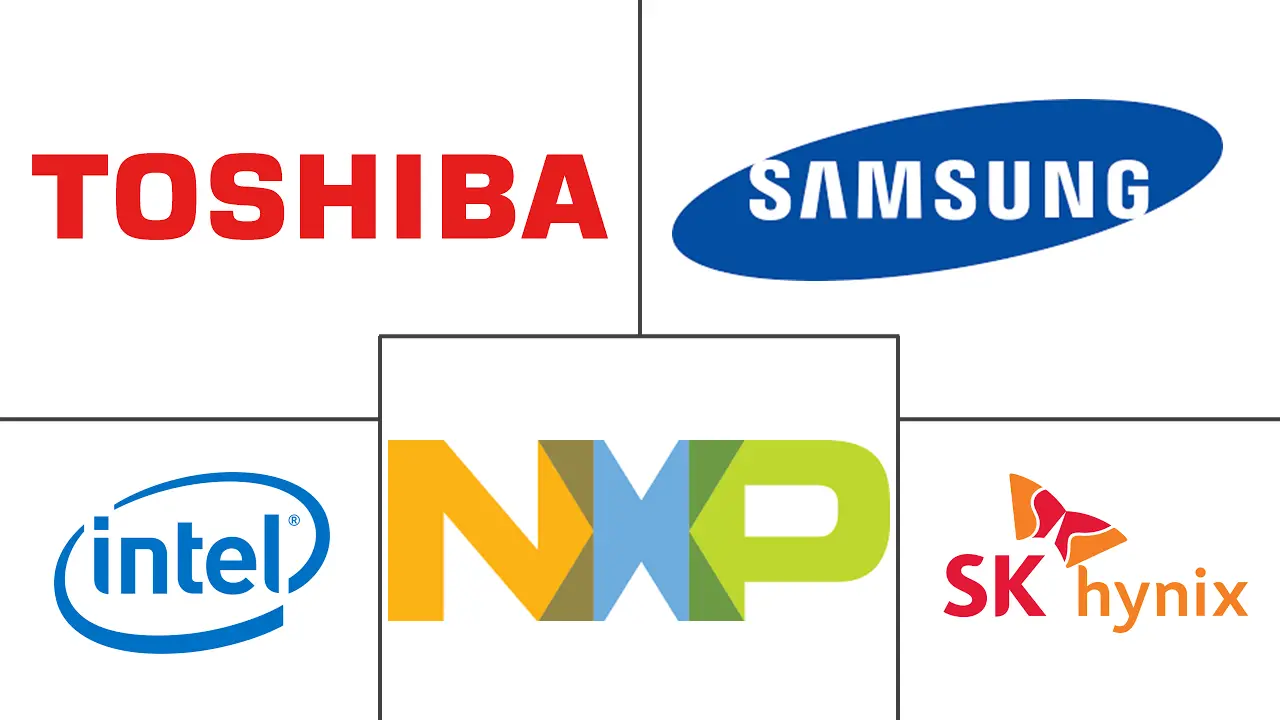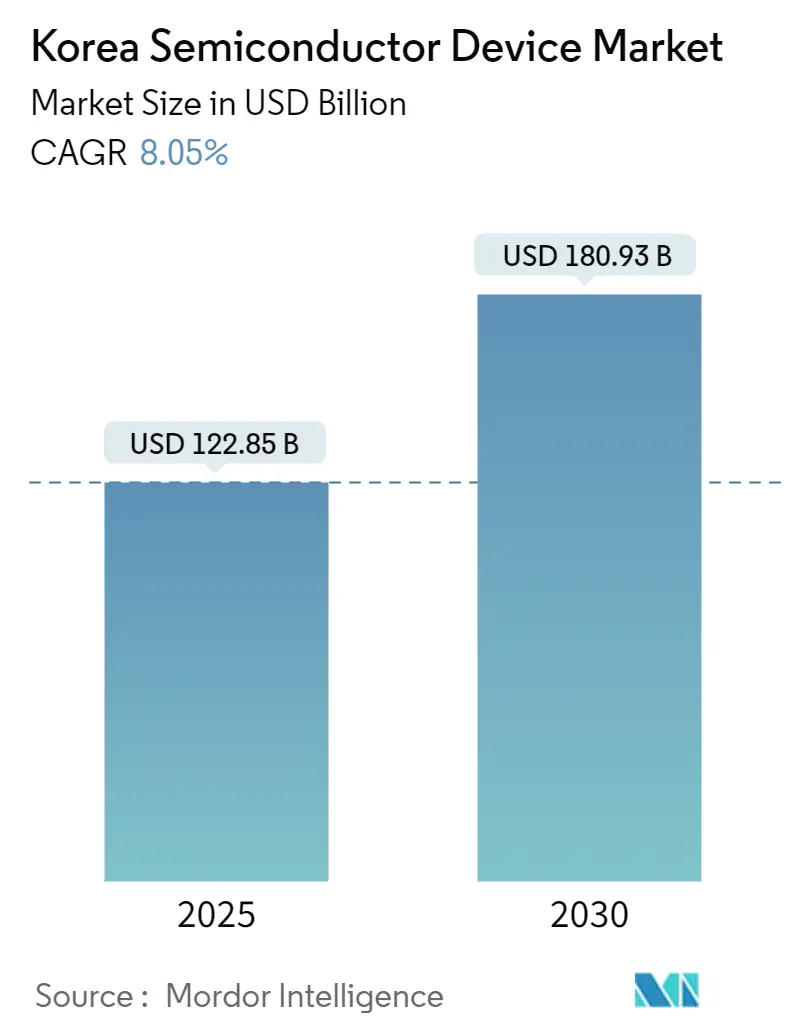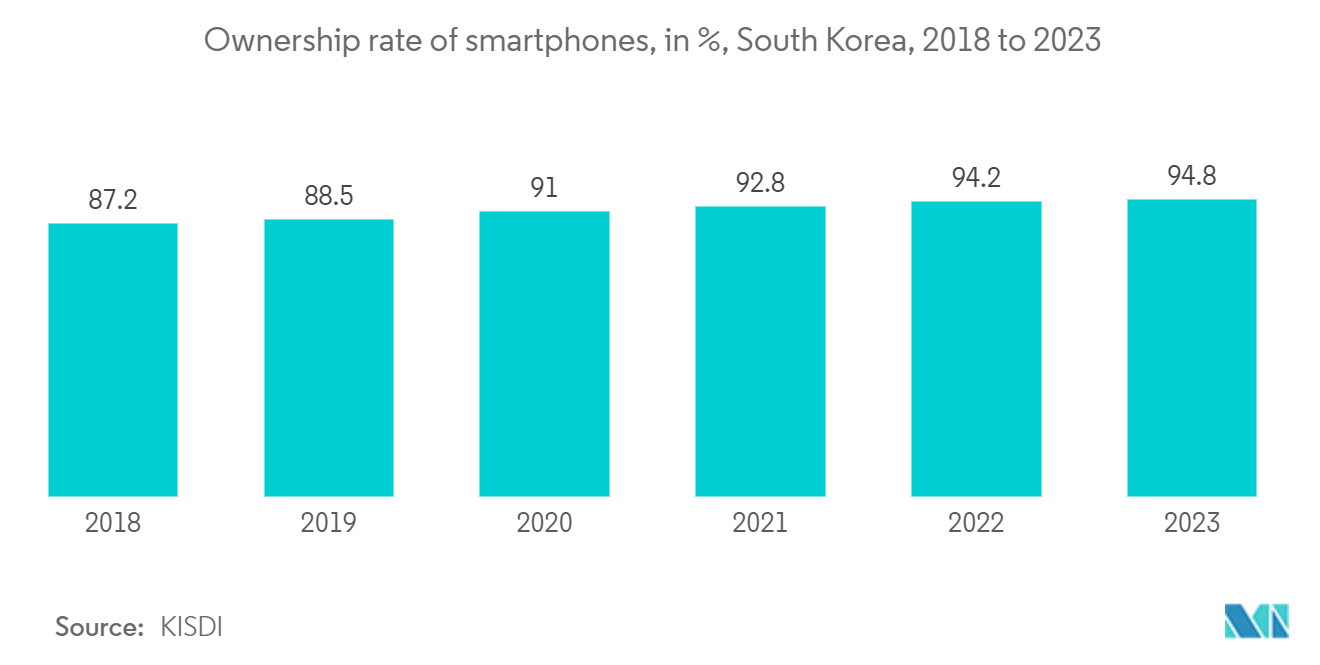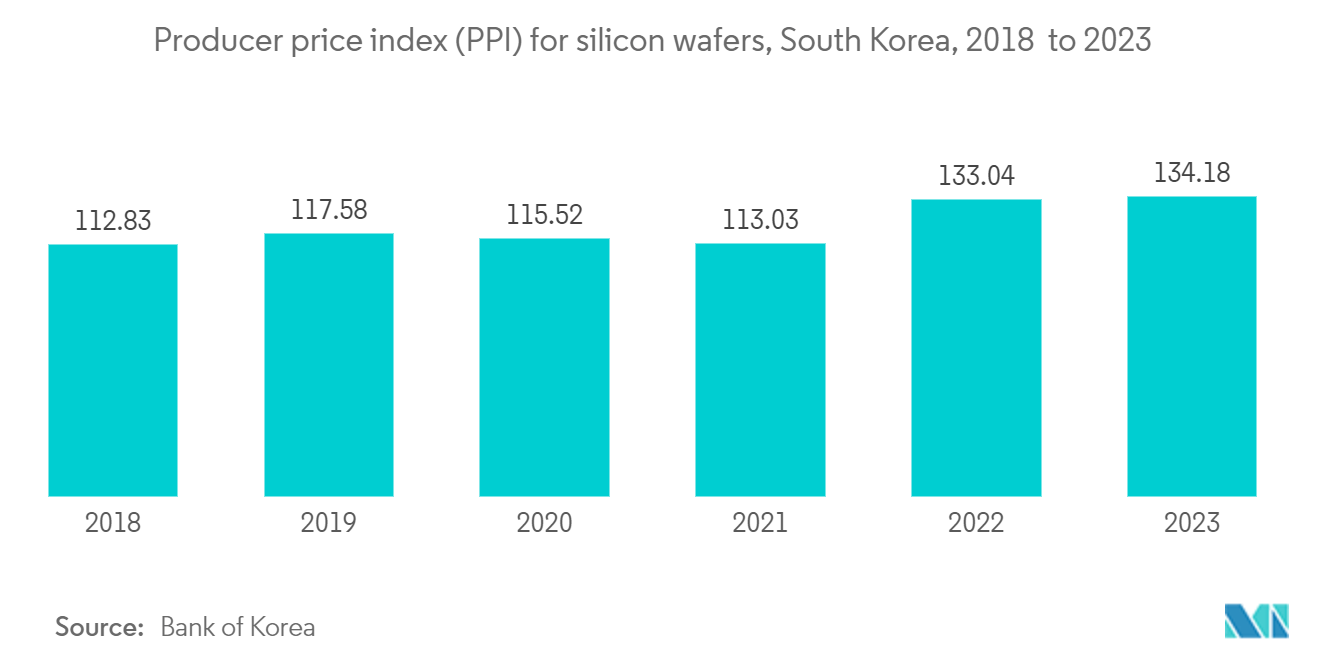Korea Semiconductor Device Market Analysis
The Korea Semiconductor Device Market size is estimated at USD 122.85 billion in 2025, and is expected to reach USD 180.93 billion by 2030, at a CAGR of 8.05% during the forecast period (2025-2030).
- The increasing demand for semiconductor devices from the electronics and automotive industries is expected to contribute significantly to revenue generation in the coming years; however, a shortage of skilled labor-intensive tasks may impede industry expansion in the coming years.
- The South Korean Government is taking several steps to strengthen its semiconductor landscape. For instance, in 2022, the Ministry of Trade, Industry, and Energy announced that chip exports are anticipated to double to USD 200 billion by 2030.
- Further, the Korean Government seeks to build a "K-Semiconductor belt" that stretches several kilometers south of Seoul and brings together chip designers, manufacturers, and suppliers. These plants are aimed to sharpen South Korea's competitive edge in the global semiconductor industry as well as localize primary semiconductor materials and equipment supplies with key semiconductor companies and their suppliers working in clusters in the midst of a global chip shortage.
- In Sep 2022, the South Korean Government announced several strategies to boost its automotive industry, including South Korea to invest KRW 95 trillion in the automobile industry over the next five years. The Government plans to produce 3.3 million electric vehicles by 2030.
- In March 2023, South Korea unveiled plans to utilize USD 234 billion in private investment to create the world's largest semiconductor cluster in the Seoul metropolitan area. The cluster would be located in the Gyeonggi province and completed by 2042. The cluster would be located in the Gyeonggi province and completed by 2042. South Korea's Trade and Industry Ministry also revealed its plans to build five high-tech semiconductor factories and attract up to 150 sub-manufacturers and fabless companies.
- Moreover, in August 2022, Hyundai Motor Group of South Korea announced that it had opted to develop its own automotive semiconductors. Hyundai Mobis, the automaker's car components business, is now ramping up its efforts to manufacture its own semiconductors. The move is considered part of a strategy to deal with the concerns of semiconductor supply shortages, which have made internal semiconductor production more critical than ever before, especially with the shift to electric vehicles. Such developments would offer lucrative opportunities for the market players.
- On the flip side, the semiconductor industry is considered to be one of the most complex industries, not only due to over 500 processing steps involved in the manufacturing and several products but also the harsh environment it faces, for instance, the volatile electronic market and the unpredictable demand.
- Depending on the complexity of the manufacturing process, there can be around 1,400 process steps in the overall manufacturing of semiconductor wafers alone. Transistors are formed on the lowest layer, but the process is repeated as numerous layers of circuits are formed to create the final product. The complexity of manufacturing semiconductor devices is likely to restrain the growth of the studied market.
- Further, according to the Korea Automotive Technology Institute or Katech, the global shortage of automotive semiconductors that started around the end of the year 2020 continued to affect the global car industry for the first half of the year 2022. Even after 2023, some companies may still feel its effects.
Korea Semiconductor Device Market Trends
The Discrete Semiconductor Segment is Expected to Drive the Market's Growth
- Devices like metal oxide semiconductor field effect transistors (MOSFETs), insulated-gate bipolar transistors (IGBTs), bipolar transistors, thyristors, rectifiers, etc., comprise the discrete semiconductors segment. Some of the main factors influencing the segment's growth include the rising demand for high-energy and power-efficient devices, the increasing prevalence of wireless and portable electronic products, and the increased use of these devices in the automotive industry due to the shift toward electrification.
- Effective power management is one of the critical themes in discrete semiconductors. In Korea, new system architectures are decreasing the size and component count of AC-DC power adapters while increasing their efficiency. Higher power transfer is made possible by new Power-over-Ethernet (PoE) standards, allowing the creation of new classes of devices like connected lighting.
- Several factors, including the underlying physics and the end-user experience, influence consumer adoption and acceptance of wearable technology in Korea. To maintain a competitive edge, discrete semiconductor Korean firms are standing to gain from being aware of the difficulties and market trends during the product design phase. Schottky barrier diodes (SBDs), junction field effect transistors (JFETs), and metal-oxide-semiconductor field-effect transistor (MOSFET) transistors are examples of power electronics devices that can reduce power losses by using a semiconductor with greater mobility and a higher critical breakdown field, such as silicon carbide (SiC).
- Today, one of the most demanded applications for power semiconductors is an uninterruptible power supply, which is typically used to protect hardware like computers, data centers, telecommunication equipment, or other electrical equipment where an unexpected power disruption could cause injuries, fatalities, serious business disruption or data loss. Uninterruptible power supply systems usually contain batteries and an inverter that uses insulated-gate bipolar transistor (IGBT).
- Vendors in the region are utilizing GaN transistors to address data center server power requirements. The high-frequency leg uses GaN switches, while the low-frequency leg utilizes superjunction MOSFETs, hence, enhancing the efficiency by up to 97.5%. The ongoing expansion of hyperscale data centers by cloud computing providers is also fueling the demand for discrete MOSFETs. Further, the use of gallium nitride (GaN) power transistors is gaining traction in many consumer electronics applications, particularly chargers. GaN switch technology has enabled a major advance in the miniaturization of chargers and adapters.
- Discrete semiconductors are used in various electronic products, including smartphones. These semiconductors perform minor electronic functions, including power conversion, voltage regulation, data transmission, and high-definition digital displays in smartphones. Some of the many discrete semiconductors used in smartphones include transistors, diodes, and power devices.
- Around 94.8% of respondents claimed to own a smartphone in a study by the Korea Information Society Development Institute (KISDI) that was conducted in South Korea in 2023, up from about 22% in 2011. Such huge smartphone adoption would drive the market.
The Industrial Segment is Expected to Witness a High Market Growth
- The automation industry has been revolutionized by integrating digital and physical manufacturing aspects to deliver optimum performance. Further, the focus on achieving zero waste production and a shorter time to reach the market has boosted the market's growth.
- According to the International Federation of Robotics Report 2021, showed South Korea had 932 robots per 10,000 members of its population. South Korea has the world's highest density of robots after three years at No. 2. For the first time, the number of industrial robots worldwide surpassed 3 million in 2021.
- In Korea, 342,983 industrial robots were in use as of 2020. According to the International Federation of Robotics (IFR), as compared to 2020, Korean demand for robots increased by 11% in 2021 in the electronics and automotive industries and 8% on average. Such a rise in industrial robots would drive the demand for the studied market.
- In Korea, Industrial 4.0 and the Industrial Internet of Things are at the center of the new technological approaches for developing, producing, and managing the entire logistics chain, otherwise known as smart factory automation. They dominate the industrial sector trends, with machinery and devices being connected via the internet.
- Moreover, huge shifts in manufacturing due to Industry 4.0 and the acceptance of industrial Internet-of-Things (IIoT) require enterprises to adopt smarter, agile, and innovative ways to advance production, with technologies that complement and augment human labor with automation and reduce industrial accidents caused by a process failure.
- Korea's commercial and public sectors have agreed to boost the number of local smart factories, with the objective of having more than 30,000 of them working with the newest digital and analytical technology by 2022.
- The Ministry of Trade, Industry, and Energy (MOTIE) of Korea has reaffirmed the government's ambitions to assist small and medium-sized businesses in adopting and expanding smart manufacturing technology. Small and medium-sized firms (SMEs) account for more than 99% of all businesses in Korea, and government data suggests that SMEs' exports are growing. Such a rise in export value would drive the studied market.
- According to the Bank of Korea, in 2023, South Korea's producer price index (PPI) for silicon wafers surged past 134 points, marking a substantial uptick from 2020 and setting a new record high. The rising trend in production costs for silicon wafers has been evident in recent years.
Korea Semiconductor Device Industry Overview
The Korean semiconductor device market is fragmented with the presence of several companies like Intel Corporation, NXP Semiconductors NV, SK Hynix Inc., etc. Companies in the market are continuously investing in strategic partnerships, product developments, mergers, and acquisitions to gain more market share. Some of the recent developments in the market are:
In September 2022, in preparation for future expansion, SK Hynix announced the construction of the M15X(eXtension), a new fabrication plant in Cheongju, Chungcheongbuk-do. The new plant is projected to be finished in early 2025. Over the following five years, KRW 15 trillion would be invested to develop the fab and set up production facilities. The fab is expected to be a two-story structure the size of an M11 and M12 combined.
In May 2022, Samsung Electronics Co. Ltd announced its development of the industry's first 512-gigabyte Compute Express Link DRAM, taking an important step toward the commercialization of CXL, which would enable extremely high memory capacity with low latency in IT systems.
Korea Semiconductor Device Market Leaders
-
Intel Corporation
-
Toshiba Corporation
-
Samsung Electronics Co. Ltd
-
NXP Semiconductors NV
-
SK Hynix Inc.
- *Disclaimer: Major Players sorted in no particular order
Korea Semiconductor Device Market News
- January 2024: South Korea is set to establish a semiconductor mega-cluster in Gyeonggi province, backed by a substantial investment of USD 470 billion from leading semiconductor companies. The project aims to be fully operational by 2047.
- December 2023: ASML and Samsung Electronics announced a joint investment of 1 trillion won to establish a cutting-edge semiconductor processing plant in South Korea. This initiative aims to advance technology for high-tech chips. Additionally, ASML is partnering with SK Hynix, a DRAM chipmaker, to enhance the efficiency of Extreme Ultraviolet Lithography (EUV) by leveraging hydrogen gas recycling technology.
Korea Semiconductor Device Industry Segmentation
A semiconductor device is an electronic component that relies on the electronic properties of semiconductor material for its function.
The Korean semiconductor device market is segmented by device type (discrete semiconductors, optoelectronics, sensors, integrated circuits (analog, logic, memory, micro (microprocessors, microcontrollers, digital signal processors)), by end-user vertical (automotive, communication (wired and wireless), consumer, industrial, computing/data storage).
The market sizes and forecasts are provided in terms of value (USD) for all the above segments.
| By Device Type | Discrete Semiconductors | |||
| Optoelectronics | ||||
| Sensors | ||||
| Integrated Circuits | Analog | |||
| Logic | ||||
| Memory | ||||
| Micro | Microprocessors (MPU) | |||
| Microcontrollers (MCU) | ||||
| Digital Signal Processors | ||||
| By End-user Vertical | Automotive | |||
| Communication (Wired and Wireless) | ||||
| Consumer | ||||
| Industrial | ||||
| Computing/Data Storage | ||||
Korea Semiconductor Device Market Research Faqs
How big is the Korea Semiconductor Device Market?
The Korea Semiconductor Device Market size is expected to reach USD 122.85 billion in 2025 and grow at a CAGR of 8.05% to reach USD 180.93 billion by 2030.
What is the current Korea Semiconductor Device Market size?
In 2025, the Korea Semiconductor Device Market size is expected to reach USD 122.85 billion.
Who are the key players in Korea Semiconductor Device Market?
Intel Corporation, Toshiba Corporation, Samsung Electronics Co. Ltd, NXP Semiconductors NV and SK Hynix Inc. are the major companies operating in the Korea Semiconductor Device Market.
What years does this Korea Semiconductor Device Market cover, and what was the market size in 2024?
In 2024, the Korea Semiconductor Device Market size was estimated at USD 112.96 billion. The report covers the Korea Semiconductor Device Market historical market size for years: 2019, 2020, 2021, 2022, 2023 and 2024. The report also forecasts the Korea Semiconductor Device Market size for years: 2025, 2026, 2027, 2028, 2029 and 2030.
Our Best Selling Reports
Korea Semiconductor Device Industry Report
Statistics for the 2025 Korea Semiconductor Device market share, size and revenue growth rate, created by Mordor Intelligence™ Industry Reports. Korea Semiconductor Device analysis includes a market forecast outlook for 2025 to 2030 and historical overview. Get a sample of this industry analysis as a free report PDF download.







